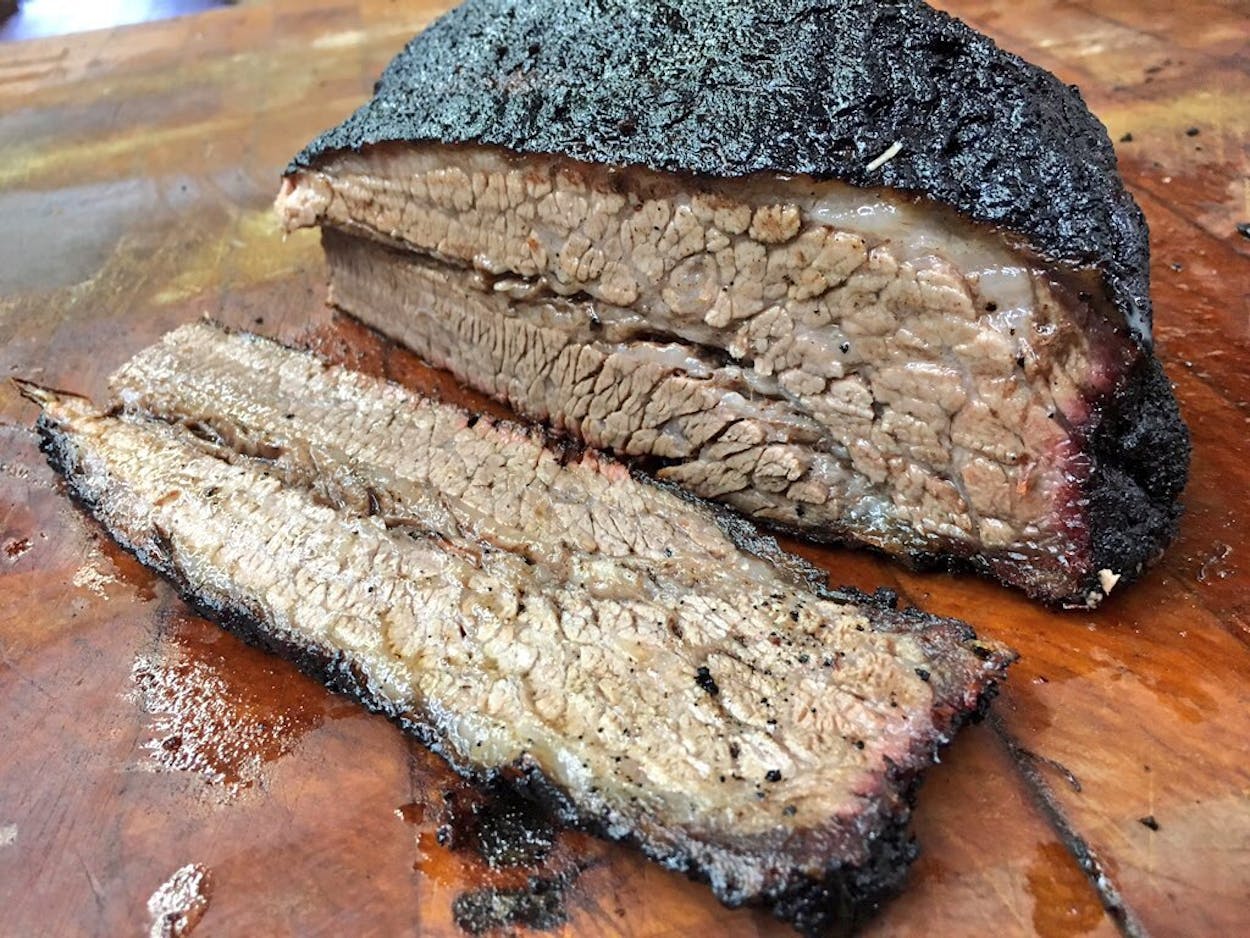Bodacious Bar-B-Que in Longview was the first stop on a barbecue road trip, and founder/owner/pitmaster Roland Lindsey, a barbecue veteran forty years my senior, boasted: “I can cook a brisket in three hours.” I called his bluff. I walked out the door promising to loop back through Longview on my way back home. Lindsey waved while stoking a mesquite fire in his old steel pit. His son-in-law Jordan Jackson cut open a fresh brisket with a smile, eager to see the results himself.
Low and slow. Hot and fast. The line between the two isn’t clear. Most folks agree that Aaron Franklin smokes his briskets in the former fashion, but his running temperature of 275 degrees hits the upper end of the definition. Kreuz Market finishes their briskets in five hours, which is hotter and faster than most anyone. That means Lindsey’s promise of a three-hour brisket assured he’d be cooking with the intensity of a blast furnace.
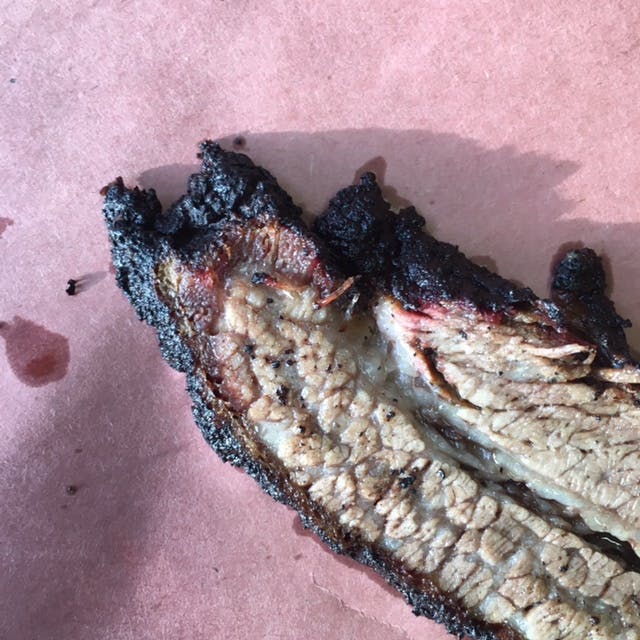
Back in Longview, the results were mixed. The direct heat used to cook the brisket had transformed all of the surface fat to crispy nuggets, some resembling chicharrones. The salty crunch was addictive. The meat itself, however, was still tough, and it dried out quickly after slicing. The fat between the point and the flat was still white, and hadn’t rendered much. It needed more time, and especially needed an extended rest on the counter to cool off. But no matter the texture, this mesquite grilled brisket had a flavor unlike any slow-smoked brisket, and I wanted to improve it at home.
The biggest hurdle with a quick cook on a full brisket is trying to get both muscles done well. As anyone who has cooked a few whole briskets knows, there’s no logical reason that we smoke them together. The point and the flat are two distinct muscles with fat content that’s nothing alike. The dense flat is prone to drying out, while the challenge of the point is cooking it long enough for all that fat and collagen to loosen up. That’s why my first step was to separate them before cooking. I also intentionally used Select-grade briskets straight from the grocery store (except one, and we’ll get to that). Starting with Creekstone Prime brisket didn’t seem as big of a challenge.
The fat layer between the two muscles is easy to identify, so removing the point from the flat isn’t a problem if you have a sharp knife. The thickness of fat makes it pretty forgiving even for those who need to work on their knife skills. What’s left is a brisket flat with full fat cap and a brisket point with fat coverage on all surfaces, allowing all the more crispy bits to be created over a hot fire.
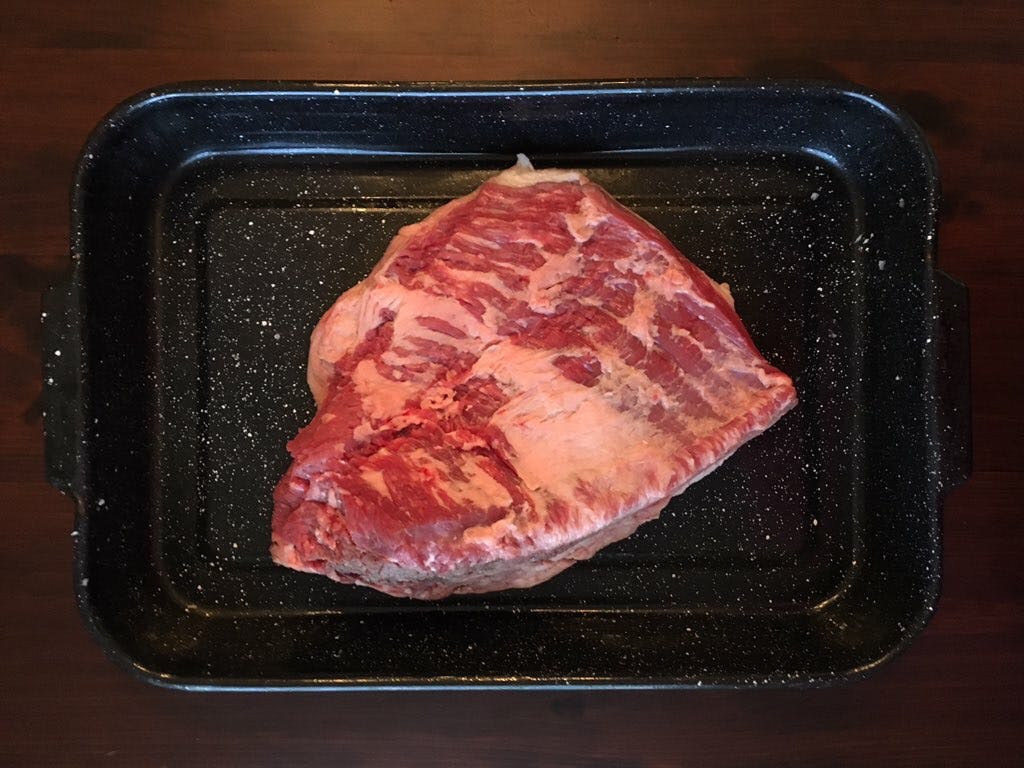
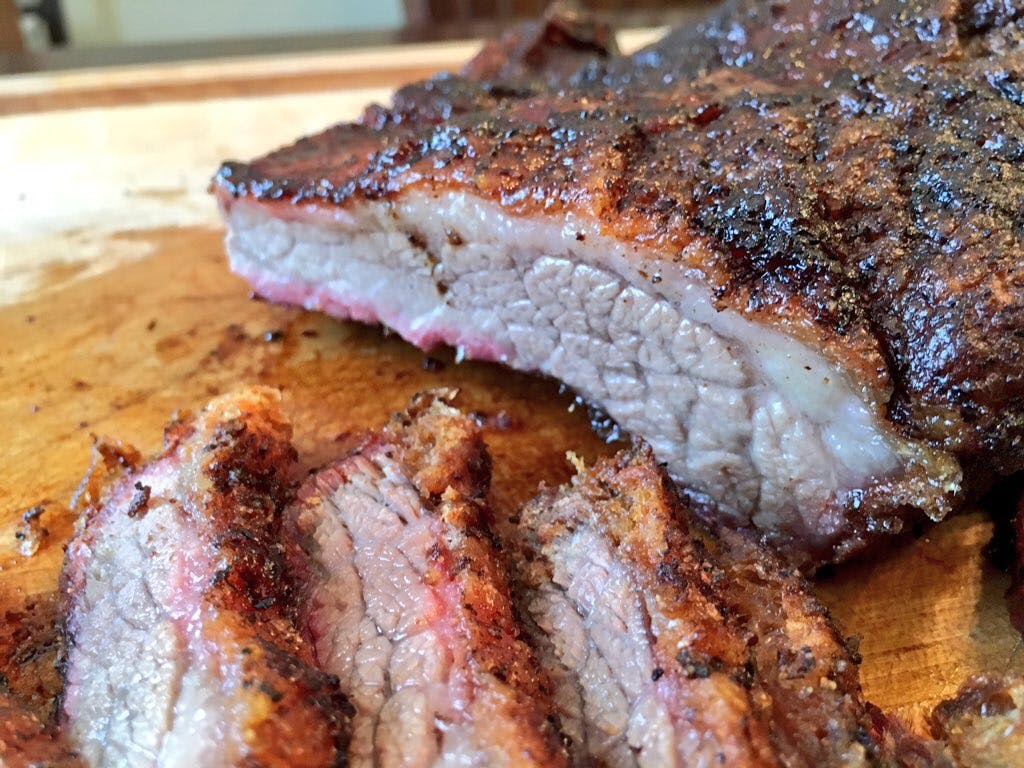
I needed a hot fire, hotter than was easily maintained in my offset smoker. A big bed of charcoal in a Pit Barrel Cooker raises the heat anywhere from 350 to 500 degrees, depending on how much oxygen you let into the barrel. My target was 400, and the first point I tried went into the pit for three-and-a-half hours at that temperature until it reached 200 degrees internally. The flat took just three hours. After a long rest (it takes about an hour to get back down to 140, my preferred slicing temperature) I sliced into them.
Both were tough. Almost none of the fat between the meat fibers of the point had rendered, and it was still springy. The flat was dry as a board, and still tough. I needed to rethink this experiment, but still make it a quick cook. I wanted tender, juicy brisket that I could start at lunch and eat for dinner.
I never got there with the flat. I even tried a Certified Angus Beef brisket because they were on sale at the store. In a moment of inspiration, I used a Middle Eastern technique of marinating tough meat in pureed onions. I mixed it with pickle juice (get it? Brisket with pickles and onions?) and let it set overnight. The onions gave the bark a unique sweetness and great flavor, but didn’t help with the tenderness. I reverted to a dual cook of smoking then roasting at a low temperature in the oven (and vice versa), but nothing worked. If sliced thin, the flats were good eating, but not a suitable replacement for slow-smoked brisket.

The points, however, seemed made for the smoke/roast technique. I started it in the hot smoker to give it some smokiness and a jumpstart, then transferred it to a 250-degree oven once it reached a 165 internal temperature. I didn’t wrap it or cover it. It just went into a roasting pan and the oven uncovered. It was done in six hours total, and the result was astounding. After resting for about an hour, I sliced into a juicy, tender brisket point. It was salty and smoky with a hefty bark of crisp fat.
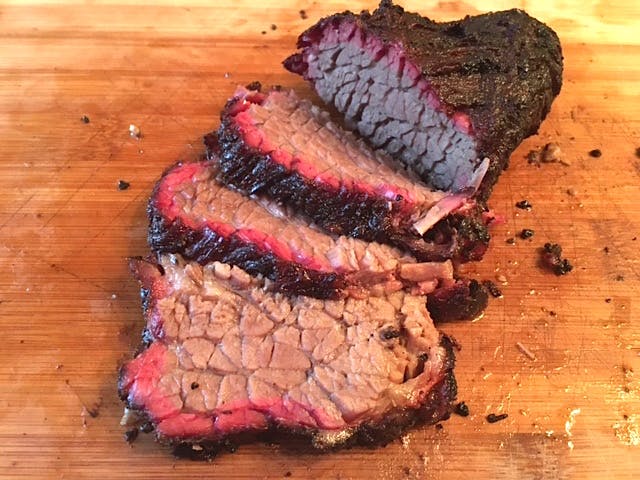
Quick aside: I’ve written before about the importance of resting, but I want to revisit that here. When a brisket (or any collagen-rich meat) is sliced into when it’s hot, it releases moisture as steam, and more liquid runs out onto the cutting board. The steam is water that is gone forever, and much of what’s on the board is melted collagen. As the meat cools, so does the collagen. Instead of the molten liquid it has become inside a hot brisket, it gets sticky again inside a cooler brisket (admittedly, this is just my theory). But think about the last time you ate good brisket with your hands: the tips of your fingers were probably sticky, so much so that maybe even some of that cheap paper napkin got stuck to your fingers. That stickiness is cooled collagen. It’s what makes a brisket feel juicy when you’re chewing it. It’s important to hold to as much collagen as possible inside the brisket if you don’t want it to taste dry. So let that brisket rest.
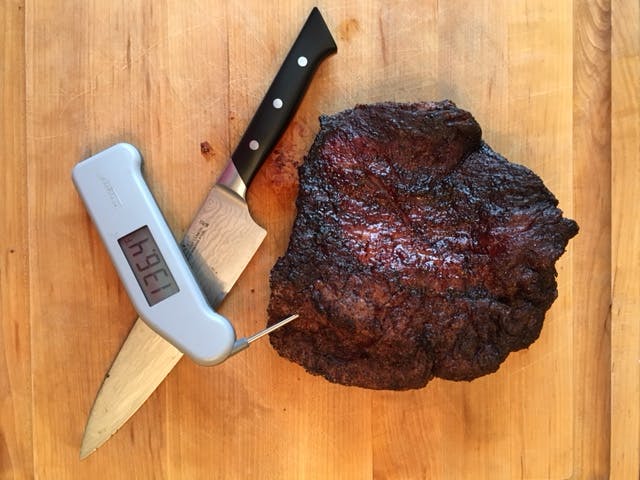
A few weeks later I tried the same method again, this time paying closer attention to the parameters. I bought two briskets, and separated the points out (the flats are in the freezer). Both went into the 400-degree smoker (one was 5 pounds, the other 5.6 pounds), and came out two-and-a-half hours later at 165 internal. After pulling them off of the smoker, one went into the 250-degree oven, and the other into the fridge. If I was using the oven for the final part of the cook, I wanted to see if that second step could be done after being chilled, and possibly stored overnight.
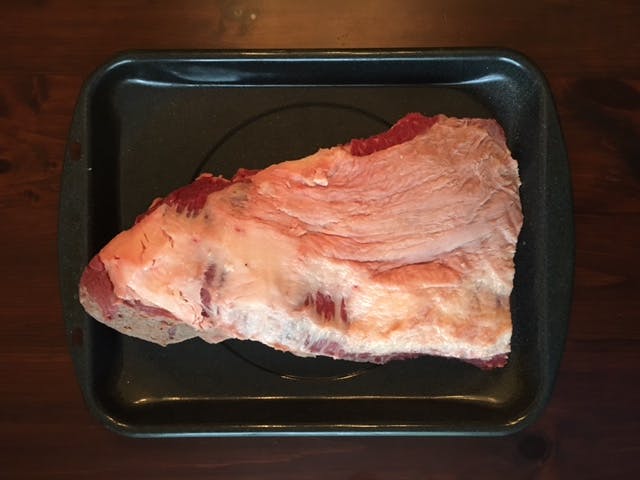
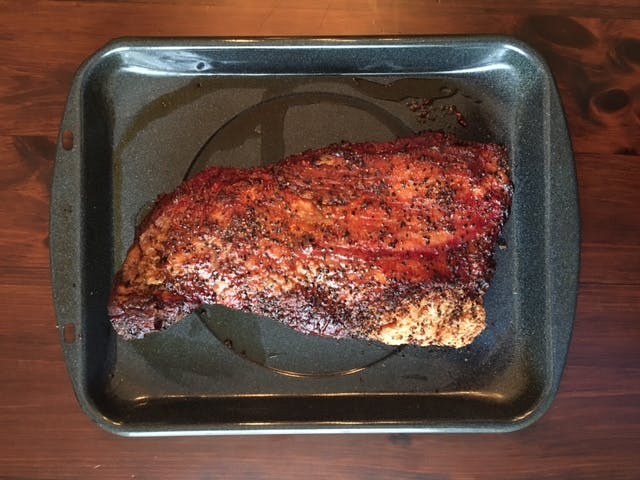
The first came out of the oven after two-and-a-half more hours (five hours total) at 195 internal. It was very good, better than many briskets I’ve been served, but still more chewy than I’d like. After the second brisket was chilled down to 40 degrees, I put it into a roasting pan and into the 250-degree oven. This time it took three-and-a-half hours to completion, which accounts for starting at a much lower internal temperature, and for hitting a target of 205 degrees internal temperature instead of 195.
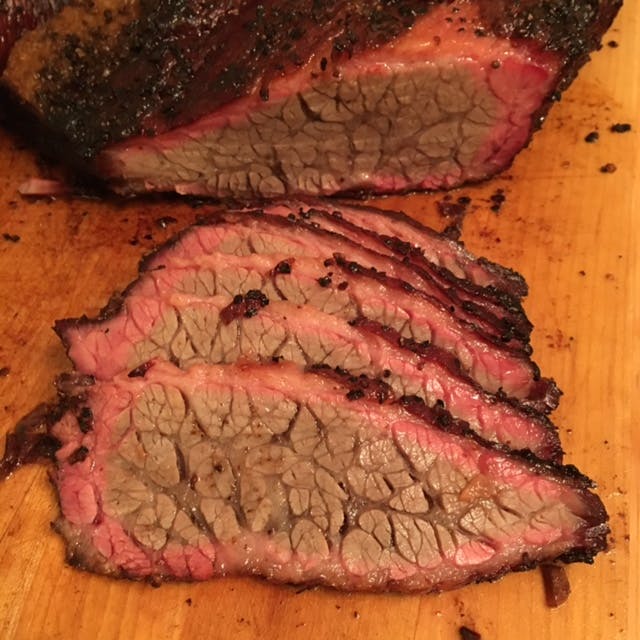
That’s a lot of numbers, but I’ll summarize it in a moment. The important part was that I had a great smoked brisket point that can be done in six or so hours, and much of the time left unattended in the oven. Even better, it could be smoked at night and finished in the oven the next day for a weeknight dinner. The code had been cracked on the hot-and-fast brisket (or the point, anyway).
RECIPE:
Sprinkle a generous amount of Kosher salt and cracked black pepper on a brisket point (five to six pounds).
Place it into a 400-degree smoker until the internal temperature reaches 165 (about two-and-a-half hours).
Transfer to a roasting pan and place, uncovered, into a 250 degree oven. Roast until the internal temperature reaches 205 degrees (two-and-a-half to three hours or longer if brisket has been chilled after smoking).
Rest at room temperature until the internal temperature reaches 140 degrees. This can take an hour, but I’ve had good luck accelerating the cooling process in the refrigerator.
Slice against the grain and serve.
- More About:
- Brisket


